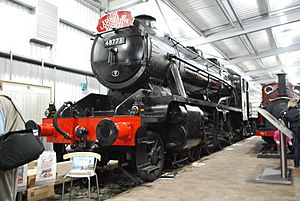LMS Stanier Class 8F 8233 facts for kids
Quick facts for kids LMS 8233 |
|
 |
|
| 48773 on display inside the Engine House on the Severn Valley Railway. | |
| Power type | Steam |
|---|---|
| Designer | William Stanier |
| Builder | North British Locomotive Company |
| Serial number | 24607 |
| Build date | 1940 |
| Configuration | 2-8-0 |
| UIC classification | 1′D h2 |
| Gauge | 4 ft 8 1⁄2 in (1,435 mm) standard gauge |
| Leading wheel diameter | 3 ft 3+1⁄2 in (1.003 m) |
| Driver diameter | 4 ft 8+1⁄2 in (1.435 m) |
| Length | 63 ft 0+1⁄2 in (19.22 m) |
| Locomotive weight | 72.10 long tons (73.26 t; 80.75 short tons) |
| Fuel type | Coal |
| Fuel capacity | 9 long tons (9.1 t; 10.1 short tons) |
| Water capacity | 4,000 imp gal (18,000 L; 4,800 US gal) |
| Boiler | LMS type 3C |
| Boiler pressure | 225 lbf/in2 (1.55 MPa) |
| Fire grate area | 28+1⁄2 sq ft (2.65 m2) |
| Cylinders | Two, outside |
| Cylinder size | 18+1⁄2 in × 28 in (470 mm × 711 mm) |
| Valve gear | Walschaerts |
| Valve type | Piston valves |
| Tractive effort | 32,440 lbf (144.30 kN) |
| Power class | LMS & BR: 7F, later 8F |
| Axle load class | Route Availability 6 |
| Withdrawn | 4 August 1968 |
| Current owner | The Stanier 8F Locomotive Society |
| Disposition | Static Display |
LMS Stanier Class 8F No. 8233 is a special steam locomotive with a long history. It has had many names, including War Department Nos. 307 and 70307, Iranian State Railways No. 41-109, Longmoor Military Railway 500, and British Railways No. 48773. Its owners believe it might be "possibly Britain's most travelled preserved locomotive" because of all the places it has been!
Contents
Building and Early Days with LMS
Locomotive 8233 was built in 1940 by the North British Locomotive Company in Glasgow. It was ordered by the War Department, which had chosen the LMS Stanier Class 8F design as their standard. This locomotive was meant to go to mainland Europe with the British army.
However, when France fell during World War II, the plan changed. Instead of going abroad, it stayed in the UK. It became LMS No. 8233 and worked from train sheds in Toton, Holbeck, and Westhouses.
An International Journey
In 1941, No. 8233 was taken by the War Department and sent to Persia (which is now Iran). There, it became Iranian State Railways No. 41-109. During its time in Persia, it had an unusual accident: it derailed after hitting a camel!
In 1944, the locomotive was changed to run on oil instead of coal. By 1948, it was in Suez and needed a new firebox. It was almost scrapped, but luckily, it was sent back to England in 1952. It then got a major repair at Derby Works. In 1954, the engine was no longer needed in the Middle East. So, it went to the Longmoor Military Railway and was named WD. No. 500.
Time with British Railways and Retirement
In 1957, No. 500 joined British Railways and was given the number 48773. It first worked from Polmadie in Scotland. It was taken out of service in 1962 but brought back in 1963. It moved to several different locations, including Carlisle Kingmoor, Stockport, Buxton, and Bolton.
As the era of steam trains was ending, No. 48773 moved to Rose Grove in July 1968. It pulled its very last main line train on August 4, 1968.
In its final years, No. 48773 had a yellow stripe painted on its cab. This stripe meant it couldn't travel south of Crewe. This was because its top-feed part was thought to be too wide for the new electric train lines. However, some train fans said this stripe wasn't needed. They believed the locomotive's top-feed had been replaced with a different type that would fit.
Preservation and Legacy
In 1968, there was a special effort to buy No. 48773 to save it. It was then restored at the Severn Valley Railway. In 1975, it took part in a big parade called the Shildon cavalcade. This event celebrated 150 years of the Stockton and Darlington Railway. In 1977, it even appeared in a BBC TV show called Survivors!
In 1986, this locomotive was given a very important role. It became a national war memorial. This was to honor all British railway transport troops who sadly died serving in the Second World War.
As of January 2014, the locomotive is on display at the Engine House. It needs a lot of work, including repairs to its mechanical parts and boiler, before it can run again. It will likely need new wheels and a new inner firebox to be operational.

